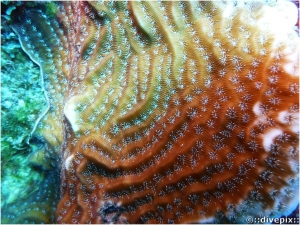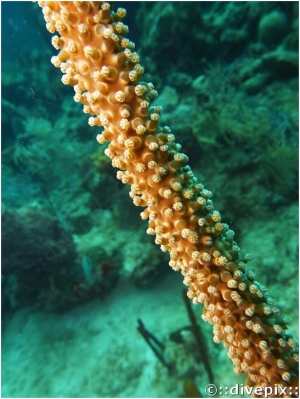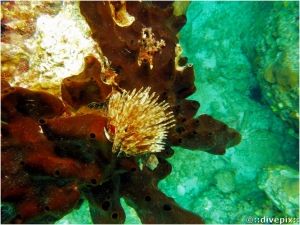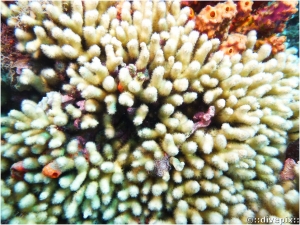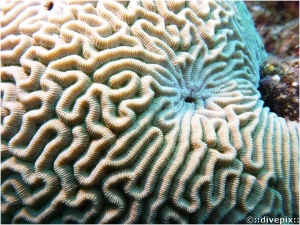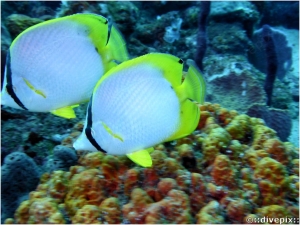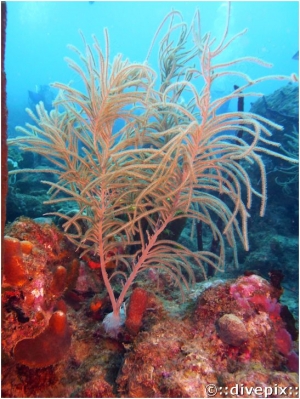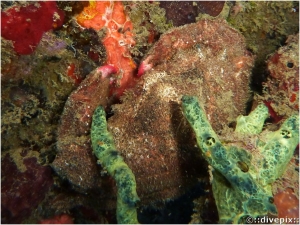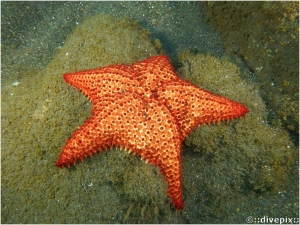




Eric H. Biass
Thursday, 03 April 2014 19:37
Saucereye Porgy
| Aspect: | Usually plain white-ish/light silver body, featuring a very pronounced humped back and steeply plunging forehead towards very low emplaced mouth. Dorsal, pectoral and anal fins translucent. |
| Population: | Common. |
| Notable feature: | Distinctive blue saucer-shaped line bordering the lower part of the eye (see red arrow on close-up view below), plain nose but light blue dots above and aft the crack of the lips. Like Sheepshead Porgy, top of body turns yellow under stress. |
| Environment: | Usually found close to bottom searching for food in coral sand, solitary. |
| Behaviour: | Ignores divers, if approached slowly. |
Published in
Porgies
Tagged under
Thursday, 03 April 2014 00:10
Whitestar Sheet Coral
| Aspect: | Colonies grow in a helix pattern and form what looks likes thinly hammer-beaten copper plates, which can be copper or verdigris coloured. Bleached specimens are affected by lack of zooxanthellae. |
| Population: | Common. |
| Notable feature: | White star-shaped polyps occupy the centre of the valleys. |
| Environment: | Grows on reef faces, often with overlapping plates. |
| Behaviour: | - |
Published in
Stony corals
Tagged under
Tuesday, 01 April 2014 12:15
Sea Rods spp.
A number of Sea Rod species are difficult to identify with absolute certainty if not observed very closely or if they polyps are not fully deployed. Others, quite on the contrary, are difficult to identify if their polyps are deployed, as is the case of the Slit Pore or the Warty Sea Rods, for example.
Published in
Octocorals
Tagged under
Monday, 31 March 2014 19:15
Dark Volcano Sponge
| Aspect: | Brown, smooth semi-hard mass, from which randomly scattered volcano chimney-shaped excurrent openings randomly emerge . Overall shape depends on substrate on which it spreads. |
| Population: | Common. |
| Notable feature: | Often homes tube worms like feather duster worms |
| Environment: | Grows on solid structure in open relatively shallow waters. |
| Behaviour: | - |
Published in
Sponges
Tagged under
Sunday, 30 March 2014 23:24
Yellow Pencil Coral
| Aspect: | Clusters of large Yellow upward-growing blunt finger-like branches that can form very large patches, or grow within the limited confines of a Barrel Sponge. Large patches may join others and thus cover up other corals over large surfaces. Fingers often branch off. |
| Population: | Common. |
| Notable feature: | Look like wooll-gloved fingers when polyps are extended. May look green as depth underwater increases. |
| Environment: | Occur in relatively shallow, but open, waters. |
| Behaviour: | - |
Published in
Stony corals
Tagged under
Sunday, 30 March 2014 19:18
Symmetrical Brain Coral
| Aspect: | Generally dome-shaped aggregation of colonies that form long and deep-cut valleys, which are home to the polyps' mouths. The ridges are neatly rounded and feature a very thin (sometimes invisible) groove at their summit, where septa meet. |
| Population: | Common. |
| Notable feature: | Light brown to brown with generally lighter coloured valleys. |
| Environment: | Most usually on steady substrates like rocks, but also shipreck surfaces, at depths ranging from only a few tens of centimetres down to more than 30 metres. |
| Behaviour: | Tentacles may sometimes extend during the day. |
Published in
Stony corals
Tagged under
Sunday, 30 March 2014 18:50
Spotfin Butterflyfish
| Aspect: | Similar in shape to the Reef Butterflydfish (q.v.) with vertical black bar across the eyes, but its white-silvery body is otherwise entirely bordered by yellow fins, including pelvic fins. |
| Population: | Not rare, but not as abundant as the other butterfly fishes seen here. |
| Notable feature: | Small black dot on rear tip of dorsal fin. |
| Environment: | Usually found in relatively shallow waters. |
| Behaviour: | Will usually swim away when approached closer than two metres. |
Published in
Butterflyfishes
Tagged under
Sunday, 30 March 2014 17:27
Slimy Sea Plume
| Aspect: | A small bush with seemingly overloaded branches bending downwards, giving the impression that they are made of heavy feathers. Branches grow pinnately (like a palm tree), from which emerge dense rows of polyps. |
| Population: | Common. |
| Notable feature: | Slighly tacky surface (hence name) due to mucus exsuded by the branches. Purple to orange branches. |
| Environment: | Generally settles on a rock or large stone in clear, relatively horzontal patches of sandy surfaces from depths of 3 to 15 metres, exceptionally deeper. |
Published in
Octocorals
Tagged under
Saturday, 29 March 2014 20:26
Redeye Sponge Crab
| Aspect: | Beige to brown, often covered in debris, and even large pieces of sponges, to appear less conspicuous, hairy legs. |
| Population: | Not abundant, but small and not very visible, which may explain apparent scarcity. |
| Notable feature: | Tip of claws are red. |
| Environment: | Usually found on or in sponges. |
| Behaviour: | Shy, often hides away. |
Published in
Crabs
Tagged under
Thursday, 27 March 2014 21:02
Cushion Sea Star
| Aspect: | Generously padded body with five wide arms. Except when white, features camaieu colouring with a lighter tone for the body and a darker shade of the same on studs - or the contrary. Colours include oranges and browns. |
| Population: | Not seen at Ilets Pigeon itself, but closer to the shores of Basse Terre right across |
| Notable feature: | Studs often form a pentagonal pattern in the centre of the body, particularly visible on the white specimen seen here. |
| Environment: | Usually found in shallow waters, on sandy sea grass-covered areas. |
| Behaviour: | - |
Published in
Echinoderms
Tagged under




